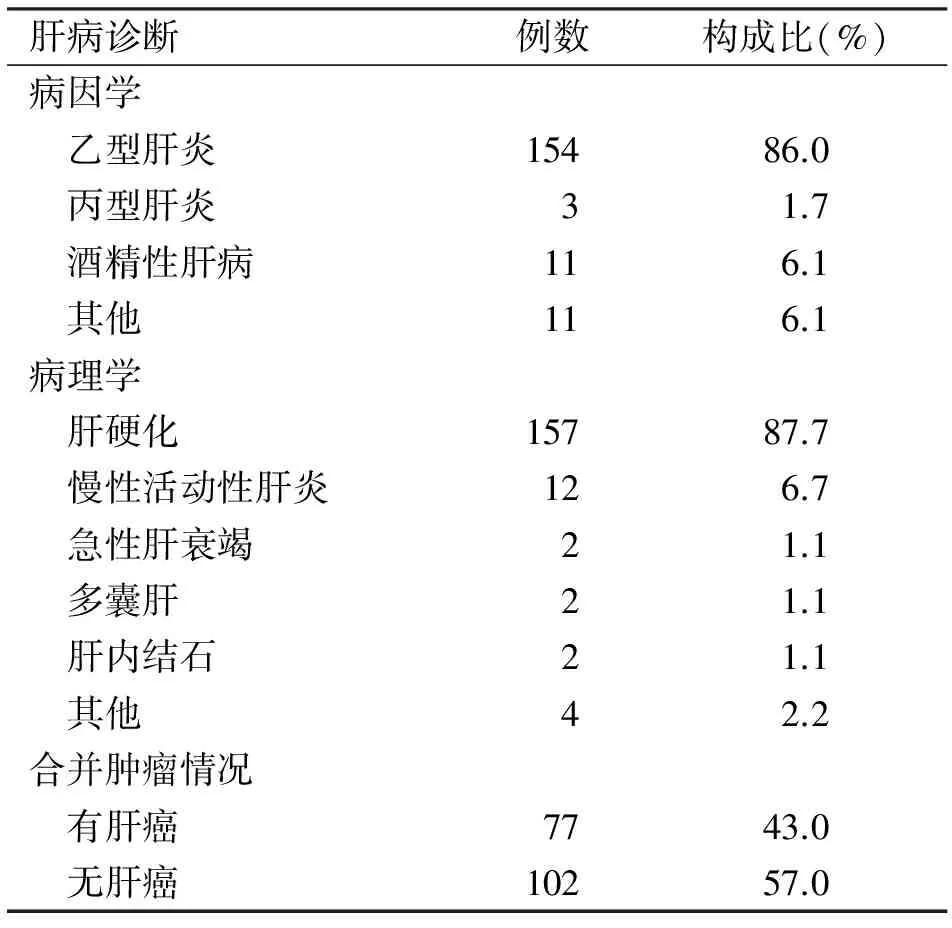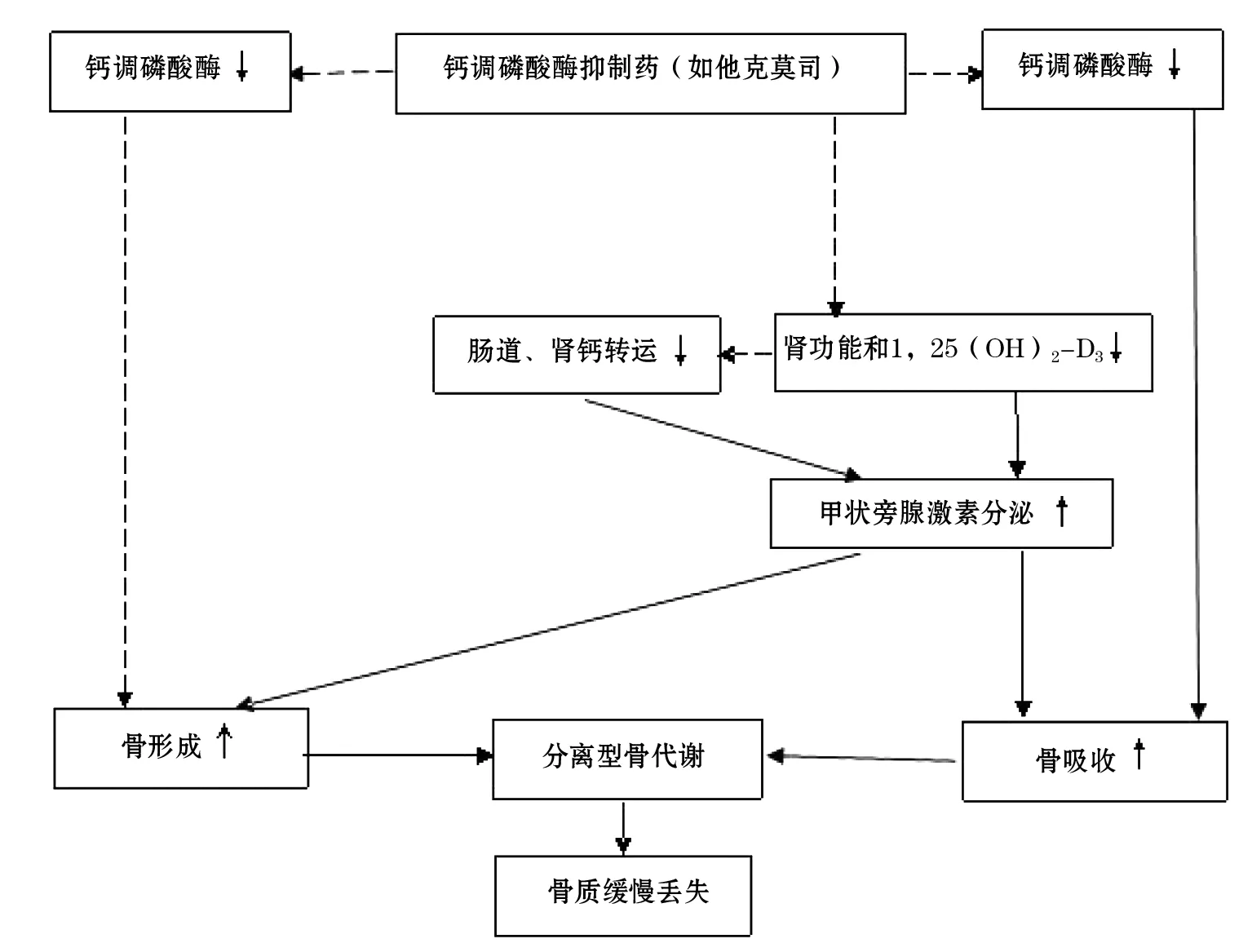肝移植术后椎体骨折发病率调查及其危险因素分析
2014-07-18王宏宇刘晓军牛玉坚
王宏宇,徐 春,刘晓军,牛玉坚
肝移植术后椎体骨折发病率调查及其危险因素分析
王宏宇1,徐 春1,刘晓军2,牛玉坚3
目的调查我院肝移植术后患者椎体骨折的患病率,分析其主要危险因素。方法选择在武警总医院随访的肝移植患者。纳入标准:(1)首次肝移植的华裔患者;(2)年龄20~70岁。排除标准:(1)妊娠或哺乳;(2)伴有其他器官移植。临床资料来源于武警总医院器官移植中心的住院和门诊病历,包括人口学特征 (年龄、性别、体重指数)、肝病史、术后免疫抑制治疗方案。入选患者检测胸腰椎正侧位X线片,通过Genant半定量分析法判断椎体压缩骨折程度。结果共入选肝移植患者179例(男151例,女28例),年龄30~69(51.5±9.3)岁,术后时间2~119(41±30)个月。椎体骨折总患病率达32.4%,其中轻、中、重度椎体骨折分别占74.1%、19.0%和6.9%。分析显示,肝移植术后椎体骨折主要与年龄、糖皮质激素和钙调磷酸酶抑制药有关,多发于术后0.5~2年,患病率可达51.4%。结论肝移植术后椎体骨折患病率高,高龄、糖皮质激素和钙调磷酸酶抑制药的使用是主要危险因素。建议在补充钙和维生素D的基础上,积极选用双膦酸盐防治肝移植后骨质疏松及骨折。
肝移植;椎体骨折;他克莫司
20世纪90年代以来,肝移植成为治疗终末期肝病的一种重要手段。欧美报道显示,21世纪初以前肝移植患者术后6~12个月骨质疏松性骨折发病率可达23%~54%,以椎体压缩性骨折最常见[1-4]。近10年来,随着免疫抑制药物的发展,术后糖皮质激素疗程明显缩短,加之双膦酸盐类药物的广泛应用,使术后骨质疏松及骨折的发病率显著降低[5,6]。近年我国肝移植患者术后免疫抑制方案虽然与欧美用药方案[1]相同,但很少使用双膦酸盐防治术后骨质疏松及骨折。本研究调查近年来我院肝移植患者椎体骨折的患病率,分析相关危险因素,为临床诊疗提供参考。
1 对象与方法
1.1 对象 2011-08-01至2013-02-01在武警总医院随访的肝移植患者。纳入标准:(1)年龄20~70岁;(2)首次肝移植的华裔患者。排除标准:(1)妊娠或哺乳;(2)伴有其他器官移植。
1.2 资料采集 临床资料来源于武警总医院器官移植中心的住院和门诊病历,包括人口学特征 (年龄、性别、体重指数)、肝病史、术后免疫抑制治疗方案。入选患者给予胸腰椎正侧位X线片检查,要求以横膈部(约T12)为中心,测量范围至少包括T8~L5。
1.3 诊断标准 采用Genant半定量分析法[7]判断椎体压缩性骨折,骨折分4级:(1)正常(无骨折,椎体压缩<20%);(2)轻度(椎体压缩20%~25%);(3)中度(椎体压缩26%~40%);(4)重度(椎体压缩>40%)。

2 结 果
入选肝移植患者179例(男性151例;女性28例),年龄30~69(51.5±9.3)岁,术后时间2~119(41±30)个月,体重指数(BMI)15.2~33.9(23.5±3.5)kg/m2。全部患者术后均使用他克莫司和糖皮质激素进行免疫抑制治疗,且糖皮质激素使用均小于3个月,仅使用钙剂和活性维生素D防治骨质疏松。统计显示,腰椎压缩性骨折患病率为32.4%(58/179),其中轻、中、重度骨折分别占74.1%(43/58)、19.0%(11/58)、6.9%(4/58)。
2.1 性别 入组女性均大于50岁且已绝经,其椎体骨折率为35.7%(10/28),略高于男性30.5%(46/151),但差异无统计学意义。
2.2 年龄 按年龄将患者分为4组:30~39岁组(n=25)、40~49岁组(n=54)、50~59岁组(n=66)、≥60岁组(n=34)。结果显示,随年龄增长椎体骨折患病率增高,分别达16.0%(4/25)、27.8%(15/54)、37.9%(25/66)、41.2%(14/34)。高龄患者(60~70岁组)椎体骨折患病率是低龄患者(30~40岁组)的2.6倍(χ2=4.3,P=0.04)。表明年龄是肝移植患者发生椎体骨折的危险因素。
2.3 体重 按体重指数(BMI)将患者分为三组:偏瘦组(BMI≤18.4)、正常组(BMI 18.5~23.9)、偏胖组(BMI ≥24),结果显示:三组患者椎体骨折患病率分别为33.3%(4/12)、31.6%(25/79)、33.0%(29/88),差异无统计学意义。
2.4 肝病史 入选患者肝病史,包括病因学、病理学及肝肿瘤情况见表1。由于病例数量有限,主要比较的椎体骨折患病率包括:乙型肝炎与非乙型肝炎患者[(51/154,33.1%)vs(7/25,28.0%)];肝硬化与非肝硬化患者[(50/157,31.8%)vs(8/22,36.4%)];合并肝癌与无肝癌患者[(26/77, 33.8%)vs(32/102,31.4%,)], 以上比较差异均无统计学意义。

表1 入组肝移植患者肝病史
2.5 免疫抑制药的使用 所有入组患者术后均使用他克莫司和糖皮质激素抗排异治疗,他克莫司于2年内逐渐减至维持剂量,糖皮质激素使用<3个月。按免疫抑制药使用情况,将术后时间分为3个阶段:第1阶段(高剂量期,术后<6个月)、第2阶段(减量期,术后6个月~2年)、第3阶段(维持量期,术后>2年),分别有患者27例、35例和117例,统计各阶段椎体骨折患病率。结果显示,1~3阶段椎体骨折患病率分别为22.2%(6/27)、51.4%(18/35)、27.4%(34/117),第2阶段显著高于第1阶段(χ2=5.5,P=0.02)和第3阶段(χ2=6.0,P=0.01)。说明肝移植术后6个月~2年阶段是椎体骨折的高发期,超过50%的患者存在椎体骨折。
3 讨 论
本中心肝移植患者腰椎骨折患病率达32.4%,且多发于术后0.5~2年,与20世纪90年代欧美的患病率相近[8,9]。而欧美的一些研究显示,近10年来随着免疫抑制方案的改进、糖皮质激素用量的减少和双膦酸盐等抗骨质疏松药物的应用,使肝移植后骨质疏松和相关骨折的发生率明显降低,其椎体骨折患病率仅2.0%[7,10]。多项研究显示,双膦酸盐能够抑制破骨细胞的功能,对防治肝移植后骨质疏松有较好的效果[11,12]。本中心肝移植患者术后应用他克莫司和糖皮质激素免疫抑制治疗,但除钙剂和活性维生素D外,未能联合应用双膦酸盐等更为有效的抗骨质疏松药物,结果椎体骨折患病率达欧美的16倍。
肝移植后椎体骨折与术前骨质状况和术后骨质丢失均有关。大样本研究显示,等待肝移植者的腰椎或髋部骨质疏松的患病率为36.6%,骨量减少的患病率为48%,而BMD正常的患者只占15%左右[13]。既往研究显示,肝移植术后骨代谢先后经历两个阶段——分离型骨代谢阶段和高转换型骨代谢阶段,主要原因是两个阶段使用免疫抑制药的种类和剂量不同[14,15]。在移植后的早期阶段,大剂量糖皮质激素和钙调磷酸酶抑制药(如他克莫司)通过多种途径抑制成骨细胞活性,增加破骨细胞的活性,骨代谢表现为分离型(成骨降低、破骨增加),骨质快速丢失(图1)。虽然该阶段骨质快速丢失,但因时间较短,骨质累计丢失量较少,骨强度的下降有限。随着糖皮质激素减量或停用,钙调磷酸酶抑制药主要增加了破骨细胞的活性[16,17],表现为高转换型骨代谢,大量骨再建陷窝形成和新生骨形成不足,骨基质矿化不充分,骨强度降低,骨折率增加(图2)。该阶段因长期持续的骨质丢失,骨质累计丢失量大,骨强度下降明显,骨折发生率最高。本研究显示,术后0.5~2年椎体骨折患病率高达50%以上。随着钙调磷酸酶抑制药逐渐减至维持剂量,骨代谢水平逐渐接近正常人群,骨质的破坏作用减低,甚至部分患者骨密度及骨强度有所恢复[16]。

图1 肝移植术后早期骨代谢

图2 肝移植术后远期骨代谢
他克莫司导致骨质丢失的具体机制尚不清楚。有研究表明,钙调神经磷酸酶(calcineurin, CaN)具有抑制破骨细胞、激活成骨细胞的作用[18]。他克莫司通过抑制CaN而解除对破骨细胞的抑制,减弱成骨细胞的分化和功能,改变成骨和破骨的动态平衡,导致骨质丢失[19,20]。这种骨质破坏,很难通过补充钙剂和维生素D得到逆转。欧美国家应用双膦酸盐防治肝移植后骨质疏松,大大降低了术后骨折的发生率,提示双膦酸盐可有效抑制肝移植后骨质破坏。
我院肝移植患者椎体骨折患病率高,术后0.5~2年是高发期,主要与年龄、糖皮质激素和钙调磷酸酶抑制药的使用有关。建议在补充钙和维生素D的基础上,积极选用双膦酸盐防治肝移植后骨质疏松及骨折。
[1] Alcalde V A, Pascasio A J M.Prevalence and characteristics of bone disease in cirrhotic patients under evaluation for liver transplantation[J]. Transplant Proc, 2012,44(6):1496-1498.
[2] Fabrega E, Orive A, Garcia-Unzueta M,etal. Osteoprotegerin and receptor activator of nuclear factor-kappaB ligand system in the early post-operative period of liver transpla- ntation[J]. Clin Transplant, 2006,20(3):383-388.
[3] Loria I, Albanese C, Giusto M,etal.Bone disorders in patients with chronic liver disease awaiting liver Transplantation[J].Transpl P,2010,42:1191- 1193.
[4] Chauhan V, Ranganna K M, Chauhan N,etal.Bone disease in organ transplant patients: pathogenesis and management[J]. Postgrad Med,2012,124(3):80-90.
[5] Kaemmerer D, Benjamin S, Gabriele L,etal.Treatment of bone loss in patients with chronic liver disease awaiting liver transplantation[J]. Transplant Res,2012,1(1): 1440-1447.
[6] Premaor M O, Das T K, Debiram I,etal.Fracture incidence after liver transplantation: results of a 10-year audit[J].Q J Med ,2011,104 :599-606.
[7] Genant H K,Wucy,Van Kuijc,etal.Vertebral fracture assessment using semiquantitativea technique[J].J Bone Miner Res,1993,8(9):113-114.
[8] Navasa M, Monegal A, Guanabens N,etal.Bone fractures in liver transplant patients[J]. Brit J Rheumatol, 1994, 33:52-55.
[9] Ebeling P R. Approach to the patient with transplantation-related bone loss[J]. J Clin Endocrinol Metab,2009,94(5):1483-1490.
[10] Wagner D, Amrein K, Dimai H P,etal.Ibandronate and calcitriol reduces fracture risk, reverses boneloss, and normalizes bone turnover after LTX[J]. Transplantation,2012, 93(3):331-336.
[11] Crawford B A, Kam C, Pavlovic J,etal. Zoledronic acid prevents bone loss after liver transplantation: a randomized, double-blind, placebo-controlled trial[J]. Ann Intern Med, 2006,144(4):239-248.
[12] Pennisi P, Trombetti A, Giostra E. Pamidronate and osteoporosis prevention in liver transplant recipients[J]. Rheumatol Int, 2007,27(3):251-256.
[13] Ninkovic M,Love S A,Tom B,etal.High prevalence of osteoporosis in patient witll chronic liver disease prior to liver transplantation[J].Calcif Tissue Int,2001, 69(6):321-326.
[14] Weinstein R S.Glucocorticoid-induced bone disease[J].N Engl J Med,2011,365(1):62-70.
[15] Sun L,Peng Y,Zaidi N,etal. Evidence that calcineurin is required for the genesis of bone-resorbing osteoclasts[J].Am J Physiol Renal Physiol,2007,292(1):285-291.
[16] Stein E, Ebeling P, Shane E. Post-transplantation osteoporosis[J]. Endocrinol Metab Clin North Am,2007,36(4):937-963.
[17] Varanasi S S, Datta H K.Characterisation of cytosolic FK506 binding protein 12 and its role in modulating expression of Cbfal and osterix in ROS 17/2.8 cells[J]. Bone, 2005,36 (2): 243-253.
[18] Fukunaga J,Yammai T,Yamachika E,etal.Expression of osteoclast differentiation factor and osteoclastogenesis inhibitory factor in rat osteoporosis induced by immunosuppr- essant FK506[J]. Bone, 2004,34(3): 425-431.
[19] Sun L,Blair H C,Peng Y,etal.Calcineurin regulates bone formation by the osteoblast[J]. Proc Natl Acad Sci USA, 2005. 102(47): 17130-17135.
[20] Armas L A, Recker R R.Pathophysiology of osteoporosis: new mechanistic insights[J]. Endocrinol Metab Clin North Am, 2012 ,41(3):475-86.
(2014-03-31收稿 2014-05-20修回)
(责任编辑 梁秋野)
Prevalenceandriskfactorsofvertebralfractureafterlivertransplantationpatients
WANG Hongyu1,XU Chun1,LIU Xiaojun2,and NIU Yujian3.
1. Endocrinology Department,2. Pharmacy Department,3. Organ Transplantation Institute,The General Hospital of Chinese People’s Armed Police Forces,Beijing 100039,China
ObjectiveTo investigate the prevalence rate of vertebral fracture in a single transplant centre and analyze the disease risk factors.MethodsLiver transplantation patients were enrolled from August 2011 to February 2013 in The General Hospital of Chinese People’s Armed Police Forces. Inclusion criteria:1.Liver transplantation for the first time; 2.Age of 20-70 years.Exclusion criteria:1.Pregnancy or lactation. 2.Other organ transplantation.The data collected from electronic medical records were as follows: demographic characteristics (age, gender, BMI), history of liver disease, immunosuppressive treatment. Frontal and lateral X-ray films of thoracolumbar spine was measured.Results179 patients were analyzed, including 151 men and 28 women, aging from 30 to 69 years old (mean age 51.5 years).The prevalence rates of vertebral fracture was 32.4%.Prevalence of slight, medium and severe vertebral fractures were 74.1%,19.0% and 6.9%, respectively.0.5-2 years postoperatively with vertebral fracture prevalence was highest, 51.4%.Prevalence of vertebral fractures after the surgery mainly involved with glucocorticoid and calcineurin inhibitor dosage, in addition to age.After surgery, the use of diphosphonate could reduce the prevalence of vertebral fractures in patients with liver transplantation in Europe and the United States.ConclusionsThere are high vertebral fracture rates in patients undergoing liver transplantation. This rate is likely to reflect long-term use of glucocorticoid and immunosuppressants .It is suggested that we should, on the basis of calcium and vitamin D, select the double phosphonic acid salt to prevent and treat osteoporosis and bone fracture after liver transplantation.
liver transplantation;vertebral fracture;tacrolimus
武警总医院课题(WZ2011009)
王宏宇,硕士,主治医师,E-mail: whyu0906@sina.com
100039北京,武警总医院:1.内分泌科,2.药剂科,3.器官移植研究所
牛玉坚,E-mail:whyu0906@sina.com
R617;R181.32
